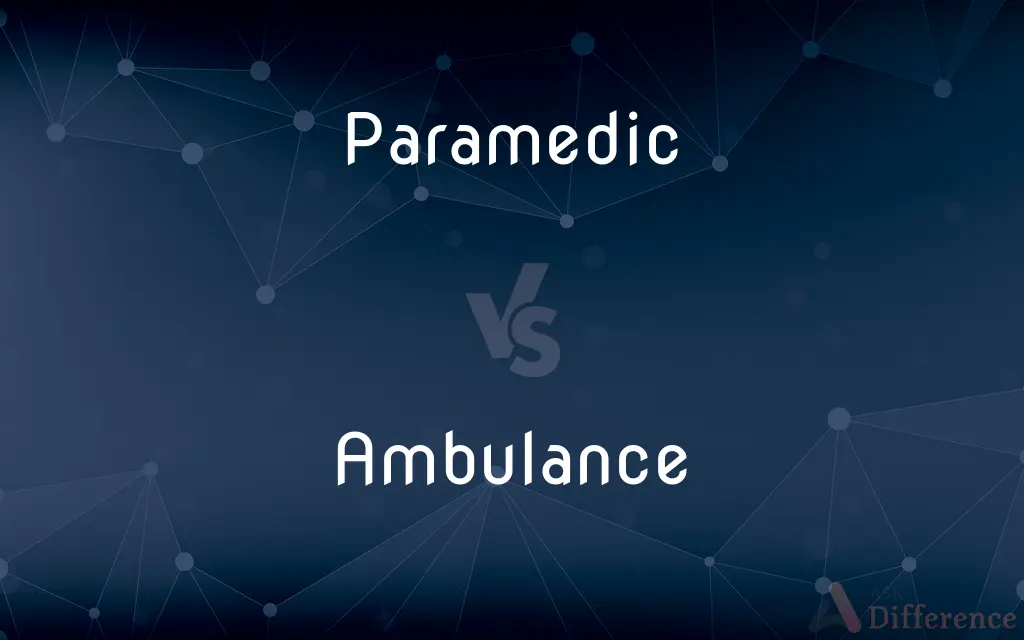Paramedic vs. Ambulance — What's the Difference?
By Urooj Arif & Maham Liaqat — Updated on April 30, 2024
Paramedics provide advanced medical care and make critical decisions, while an ambulance is a specially equipped vehicle for transporting patients.

Difference Between Paramedic and Ambulance
Table of Contents
ADVERTISEMENT
Key Differences
Paramedics are highly trained healthcare professionals specializing in emergency medical services. They are equipped to perform advanced life support, administer medications, and manage emergencies. On the other hand, an ambulance serves as the transportation means, equipped with medical equipment like defibrillators and oxygen tanks, used to bring patients to medical facilities.
A paramedic’s role is dynamic, requiring quick decision-making and medical intervention in critical situations. They operate on the front lines of medical emergencies, providing the first point of clinical care. Whereas ambulances are designed to support these functions, acting as mobile medical units where paramedics can begin treatment en route to the hospital.
The training for paramedics is extensive, often requiring a two-year degree or a diploma in paramedicine, along with certification in advanced life support. While the ambulance itself does not require training, the personnel operating it, especially the driver, must be trained in emergency vehicle operation and basic life support.
In terms of functionality, paramedics can work independently or as part of a team to deliver emergency medical care. Ambulances, however, are merely the vehicles that facilitate the work of paramedics by providing a safe and equipped environment for transporting and treating patients during transit.
When considering employment, paramedics are employed by hospitals, fire departments, or private ambulance services, showcasing their versatile role in healthcare. In contrast, ambulances are assets owned and maintained by these services, indicating their supportive role in the operational aspect of emergency medical services.
ADVERTISEMENT
Comparison Chart
Function
Provides medical treatment
Transports patients
Training Required
Yes, extensive medical training
No, but drivers need operation training
Role in Emergency Care
Primary caregiver
Supportive transport role
Equipment
Medical kits, defibrillators
Equipped with medical devices
Employment
Hospitals, fire departments
Owned by hospitals, EMS agencies
Compare with Definitions
Paramedic
A healthcare professional who provides emergency medical treatment.
The paramedic administered CPR to the patient immediately upon arrival.
Ambulance
Operated by trained emergency service drivers.
The ambulance driver navigated through heavy traffic to reach the hospital quickly.
Paramedic
Often the first healthcare provider at the scene of an accident.
Paramedics quickly assessed the situation at the car crash.
Ambulance
Can be part of hospital, fire department, or private services.
The private ambulance service responded to the suburban accident.
Paramedic
Trained in advanced life support techniques.
As a paramedic, he was prepared to intubate the patient if necessary.
Ambulance
A vehicle equipped for transporting the ill or injured.
An ambulance was dispatched immediately following the emergency call.
Paramedic
Part of a rapid response team in emergencies.
The team of paramedics arrived within minutes after the 911 call.
Ambulance
Integral to the emergency response system.
The ambulance reached the scene with all necessary life-support systems.
Paramedic
Works in various environments, from ambulances to emergency rooms.
The paramedic transferred care to the ER team seamlessly.
Ambulance
Contains essential medical equipment like oxygen and defibrillators.
The ambulance crew used the onboard equipment to monitor the patient's heart rate.
Paramedic
A paramedic is a health care professional whose primary role is to provide advanced emergency medical care for critical and emergent patients who access the emergency medical system. Not all ambulance personnel are paramedics.
Ambulance
An ambulance is a medically equipped vehicle which transports patients to treatment facilities, such as hospitals. Typically, out-of-hospital medical care is provided to the patient.
Paramedic
A person who is trained to give emergency medical treatment or assist medical professionals.
Ambulance
A specially equipped vehicle used to transport the sick or injured.
Paramedic
An individual trained to medically stabilize people through various interventions, victims of trauma or medical events outside of a hospital setting and preparing them for transport to a medical facility.
Ambulance
An emergency vehicle designed for transporting seriously ill or injured people to a hospital.
Paramedic
(US) An individual who is licensed at the state or national level to practice medical interventions in an emergency pre-hospital setting.
Ambulance
(military) A mobile field hospital.
Paramedic
A person trained to assist medical professionals and to give emergency medical treatment
Ambulance
A prairie wagon.
Ambulance
(transitive) To transport by ambulance.
Ambulance
A field hospital, so organized as to follow an army in its movements, and intended to succor the wounded as soon as possible. Often used adjectively; as, an ambulance wagon; ambulance stretcher; ambulance corps.
Ambulance
A vehicle that takes people to and from hospitals
Common Curiosities
What is a paramedic?
A paramedic is a specialized healthcare professional skilled in emergency medical services and advanced life support.
What are the essential equipments found in an ambulance?
Essential equipment includes a stretcher, oxygen, defibrillators, and first aid supplies.
What is an ambulance?
An ambulance is a vehicle specially equipped to transport patients in need of medical care, often containing life-saving equipment.
Can paramedics perform surgeries?
No, paramedics are not licensed to perform surgeries but can perform advanced emergency medical procedures.
How long does it take to become a paramedic?
It typically takes about two years of specialized education and training to become a certified paramedic.
What’s the difference between a paramedic and an EMT?
Paramedics have more advanced training and can perform more complex procedures than EMTs (Emergency Medical Technicians).
Can paramedics prescribe medication?
Paramedics can administer certain medications under emergency circumstances as authorized by protocols.
Is an ambulance always necessary for emergency care?
While not always necessary, ambulances provide critical transport and initial treatment facilities in many emergencies.
Are all paramedics trained in childbirth?
While not all, most paramedics are trained to handle emergency childbirth situations.
How often do paramedics work with other emergency services?
Paramedics often collaborate with police, fire services, and other emergency responders.
What impact do paramedics have on survival rates in emergencies?
The presence and actions of paramedics significantly improve survival rates in severe medical and trauma emergencies.
Who drives an ambulance?
Ambulances are driven by drivers who have special training in emergency vehicle operation.
Can an ambulance operate without a paramedic?
Yes, ambulances can operate with EMTs or other medical personnel, but paramedic presence enhances the level of care.
What kind of maintenance does an ambulance require?
Ambulances require regular maintenance to ensure all equipment is functional and the vehicle is safe to drive.
What types of emergencies do paramedics respond to?
Paramedics respond to all types of emergencies, including accidents, heart attacks, strokes, and trauma cases.
Share Your Discovery

Previous Comparison
Proficient vs. Intermediate
Next Comparison
Candy vs. LolliesAuthor Spotlight
Written by
Urooj ArifUrooj is a skilled content writer at Ask Difference, known for her exceptional ability to simplify complex topics into engaging and informative content. With a passion for research and a flair for clear, concise writing, she consistently delivers articles that resonate with our diverse audience.
Co-written by
Maham Liaqat















































